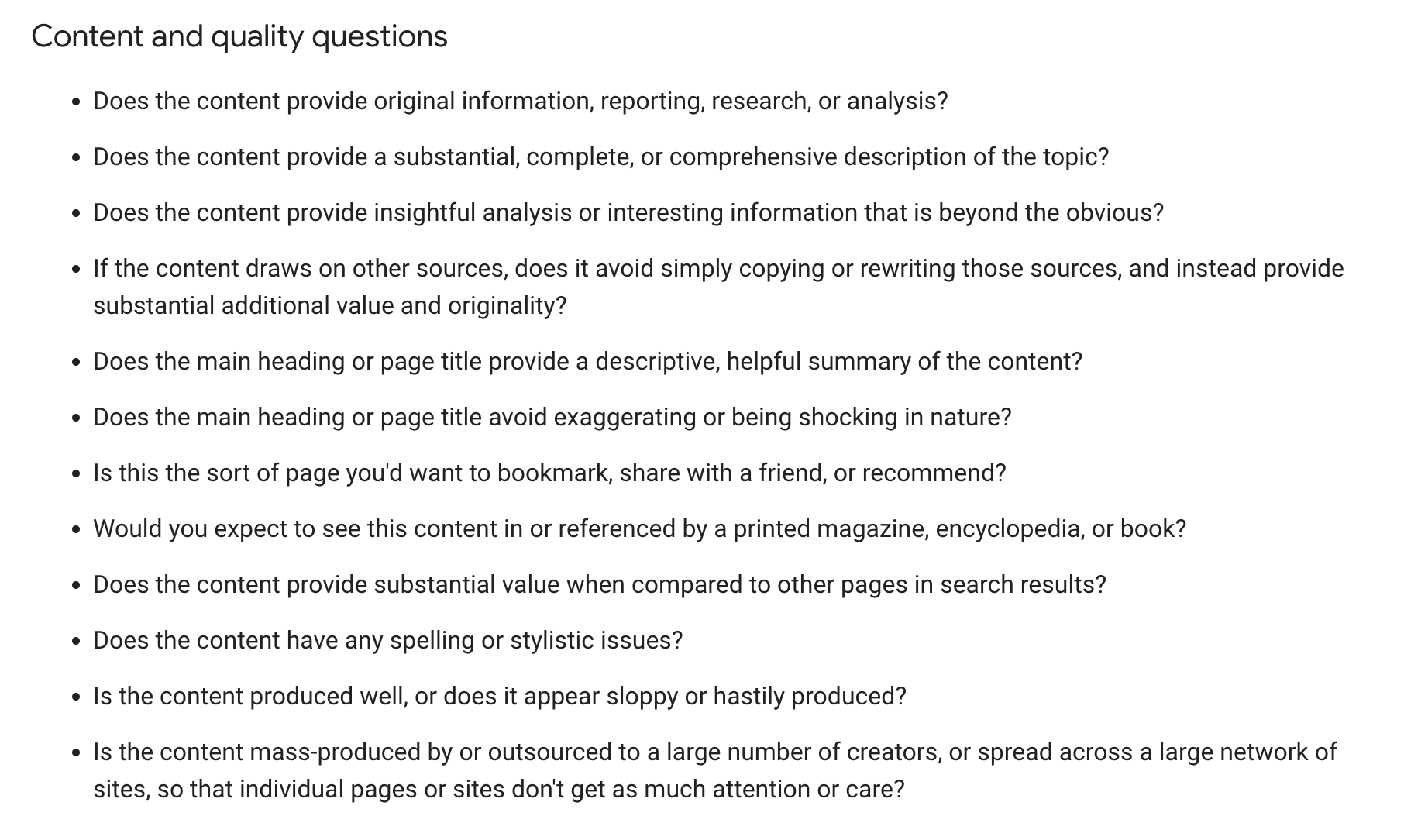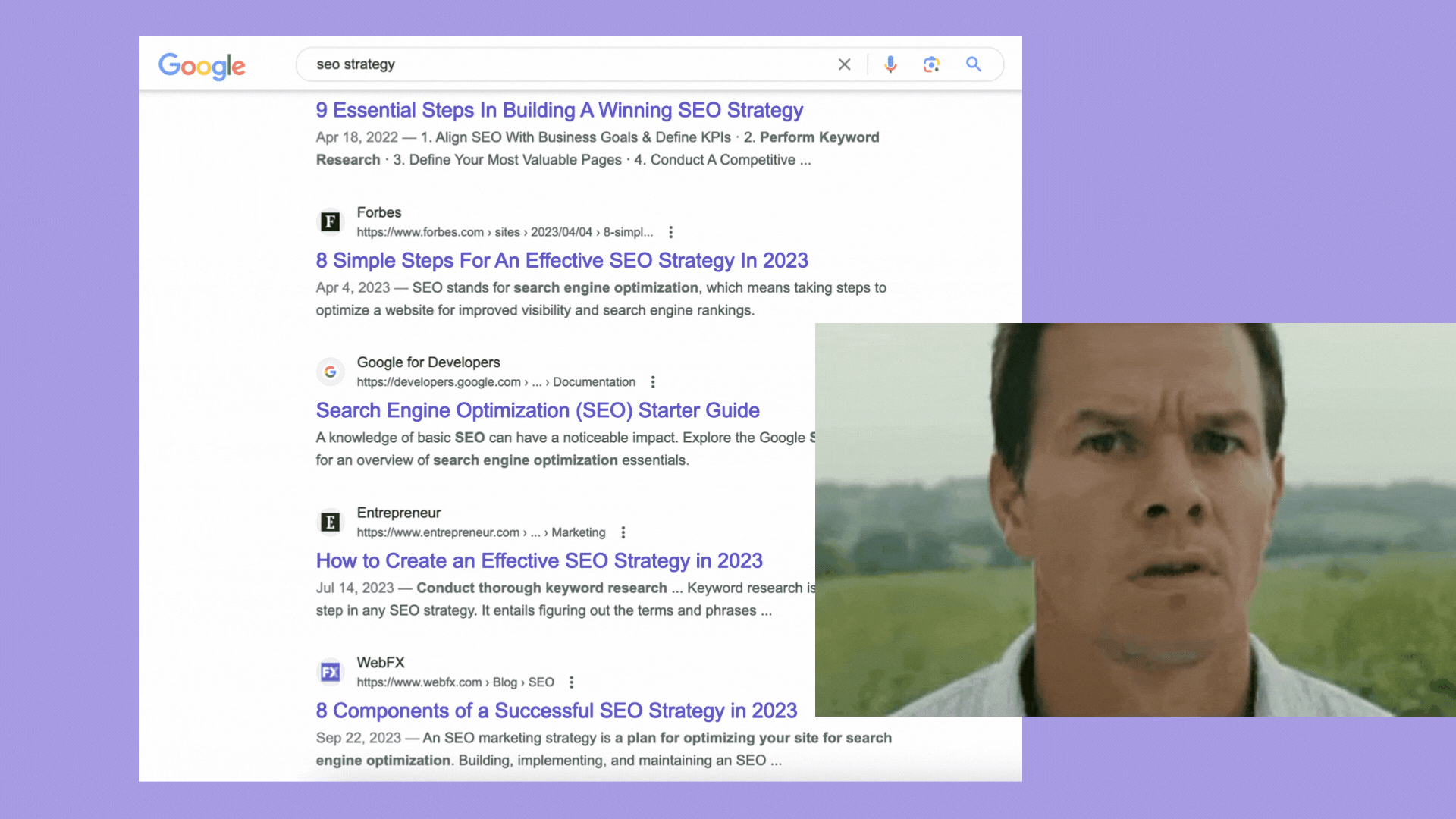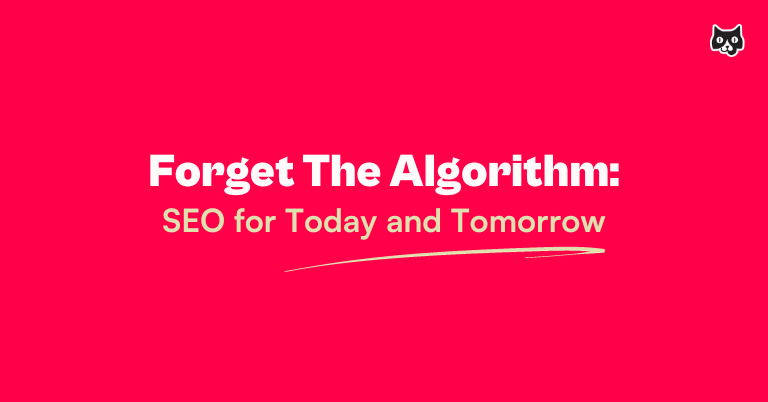The evolution of AI and advanced search technologies means today’s best practices will soon be antiquated, if they aren’t already. But worrying too heavily about the algorithm is a waste of time.
What we should be doing is stop trying to decode algorithmic updates and start aligning with Google’s objective: providing helpful content to users.
What’s beautiful is that it means your current SEO work will be able to more seamlessly blend with your journalism, thought leadership, and demand generation work—it doesn’t need to be its own silo. Effectively, Google doesn’t want it to.
In the face of Search Generative Experience, Bard and other new ways to search for and receive answers, it’s not the rules and results of the algorithm that will drastically change: it’s search behavior and the search ecosystem itself.
AI has always been at the heart of Google: they were one of the first tech companies to use machine learning in its products, and AI has driven the algorithm all along from spelling corrections to image recognition to understanding complex queries. Generative AI isn’t even new.
Six years ago, Google released its revolutionary Transformer paper, which laid the groundwork for the neural network architecture for most of today’s generative AI and large language models.
Yet people are always trying to “understand” and “monitor” the algorithm, as if some special sequence of keywords and links is finally going to unlock an eternal seat on page 1.
Things are simpler than that, and an obsession with algorithmic updates is but a distraction. Today’s SEO needs only focus on the same thing as Google: providing helpful content to the user.
Google has never veered away from its main goal: to provide accessible and useful information to the user when and how they want it. Every algorithmic update since the beginning has brought us closer to this goal, and every update to come will do the same.
SEO is not dying, it’s being reborn. And there’s something we can all do to claim our spot in the SEO renaissance.
We’re a little too obsessed with the algorithm
We say things like “SEO is always changing” and that “it’s too hard to keep up with the algorithm”. But the basic premise of good SEO hasn’t changed in years.

The details most people obsess over just don’t matter in the end. The answer to “why did I get hit by the algorithm?” has been the same for 5 years: you’re not providing the best, most trustworthy answers to the user.
We constantly look for new tactics, new ways to beat the algorithm.
- Will “content velocity” solve all my slow growth problems?
- Which keyword is the perfect one for me to choose?
- Is it normal that I lost 70% of my traffic in the last update?
- Can increasing my domain authority be the answer?
- Does the Ahrefs audit need to report 0 issues for me to feel okay?
- How many words should this blog post be?
- How many times and where should I include the primary keyword?
Yes, SEO can be complex, but the overall idea is simple and bears repeating: provide helpful, trustworthy answers to questions.
- Content velocity can help you grow fast, if the content you are speedily publishing is relevant and trustworthy.
- There is no such thing as the “one perfect keyword”—just choose a topic that is relevant to your user, match the intent, and move on.
- Increasing domain authority may or may not help you.
- The number of words in a blog post don’t matter.
- The Ahrefs audit is, for lack of a better description, a big list of distractions.
- And finally, if you do not provide expert, trustworthy and helpful content to your users, then yes, it is normal that you lost 70% of your traffic in the last update.
When we obsess over the details, we forget the big picture. Most of all, we lose sight of what we really should be obsessing about. The user.
Thing is, if you really followed the algorithms and obsessed over them, your focus would already be on the user. This is exactly where the algorithm has been heading all along.
Have algorithm updates been all that different?
Every update in the last 4 years has had two purposes:
- Get rid of bad content and links
- Reward helpful content and links
Google’s lifelong battle has been getting rid of spam results, yet we keep asking ourselves why we got hit when 90% of our content is thin and generated by bots.
Product Review Updates
In Google’s attempt to make product reviews more helpful, in the last two years, it’s released multiple iterations of the product review updates that said you should have first-hand experience using a product to review it. And you should be able to prove it, too—with screenshots or videos of you using it, and expressions like “when I used this, I found that…”
Helpful Content Update
Then, we had the Helpful Content updates that promote original content written to help people. Guidelines include adding first-hand experience, subject-matter expertise, and with explicit instructions not to write with search engines in mind.
The algorithm was super volatile when SEO was a new industry, and nobody forgot
Every core update since 1998 has meant to bring users one step closer to SERP nirvana: the one place that organizes the world’s information and makes it universally accessible and useful.
But of course, since search engines were new and fresh, we were all trying to figure out together how we’d use them. Back then, Google could only guess how SEOs and business owners might try to rig the system. No wonder the algorithm changed drastically and frequently—and SEOs are still traumatized by it.
I suspect that when people talk about the algorithm, they’re referring to legacy aspects like PageRank, introduced in 1998 and later replaced in 2006—thinking that updates like these are still happening.
While understanding these foundational elements is crucial, it’s not what we mean by “keeping up with the algorithm.” These basic principles are about the same as they were when the Spice Girls were last touring.
Google has always scratched its head over how exactly to deem content trustworthy. For instance, the 2008 Vince update favored larger, more established brands, with the hypothesis that “big brands must be more trustworthy!”. They quickly learned that was a poor move, but it was all a part of the learning curve.
It’s not new that Google’s results have been under intense scrutiny. That’s why the company rolled out the Panda update in 2011, effectively eradicating content farms from top search results. The following year, Google released the Penguin update, targeting link schemes—specifically websites with suspicious linking patterns, including an overuse of exact match anchor text to game keyword rankings—and keyword stuffing.
And then came BERT.
Why are we still stuck pre-BERT?
But alas, we continue to obsess over tactics and keywords.
In 2019, Google released BERT. BERT (Bidirectional Encoder Representations from Transformers) is a natural language processing (NLP) algorithm. It’s designed to maneuver ambiguous sentences and phrases with lots of words that can have multiple meanings.
BERT was the coup de grâce that should have ended the era of keyword stuffing and exact keyword matching. But we struggle to let go.
It means Google understands you almost like a person does, rather than needing very specific keywords.
This was when we started fangirling over long-tail keywords and when search intent began trumping keyword usage. Given BERT’s focus on understanding the relationships between words, semantic SEO strategies, like using Latent Semantic Indexing (LSI) keywords and creating topic clusters, became more important at this time.
This was 4 years ago, yet we still haven’t been able to let go of the idea of “keyword optimization” and finding “the perfect keyword”.
How Google reads content hasn’t changed drastically since BERT. What’s changed is how it qualifies content as good or bad.
Since BERT, all the updates have been focused on answering the question “What does helpful content look like?”
The algo Gods have spoken: “Helpfulness is King”
For those of us who just want to use search to drive business revenue—the concept of “helpfulness” can feel enigmatic.
The truth is that we don’t need to guess. Google has made extremely easy-to-follow guidelines on the topic, with step-by-step instructions.
It’s just that businesses did so well, for so many years, publishing what is today known as “SEO content”. You could get a cheap writer to read the top 10 pages ranking for the same keyword as you, spin up a new article devoid of any new information, plop on some internal and maybe even external links and call it a day.
It would work, it would rank.
And when you did that repeatedly, with a large volume of content, it was glorious for business owners. Less so for people trying to find useful information.
Now, Google says its Helpful Content guidelines are going to be even more crucial. Google repeatedly publishes statements like the following: “If there’s an update, chances are, there’s nothing to do for most creators who have already been working to create helpful, reliable, people-first content. That’s what our systems seek to reward. Those doing so will largely seek updates come and go without notice, or they might find themselves performing better in search.” And we need to take heed.
If you answer these questions correctly, you’re more likely to be rewarded in today’s SERP, but especially in the SERP of the future—which includes SGE:

Unfortunately, the practices businesses used to win with before meet very few of these criteria. Google is getting serious about E-E-A-T (Experience – Expertise – Authority – Trustworthiness) in the content it allows on page 1.
SEO content creators haven’t quite caught on yet. In the aim to “match search intent”, the entirety of page 1 results look overwhelmingly identical.

When the SERP results are impossible to distinguish
Users don’t want to sift through third-party, AI-generated content that lacks depth and try to figure out what’s going to really help them.
SERP fatigue is real.
So they’re going to Slack communities, online forums, or even TikTok—where the content is user-generated, raw, authentic, and most of all: demonstrates first-hand experience.
Google isn’t ignorant of that, and it’s not ready to lose its market share. It’s aggressively pushing the algorithm to recognize first-hand experience, creator-first content, expertise, and other trust signals in the content it allows on its SERPs.
With SGE becoming a more prominent part of search, those who continue to hold on to old tactics will be wiped from results.
If it’s not the algorithm to obsess about, it’s search behavior
The algorithm is going to continue going in the same direction: get more helpful, get less spammy. It’s going to keep moving away from keywords and toward natural, conversational language.
So now that we’ve settled that, it doesn’t mean to stay complacent and act like nothing is going to change.
There are big changes coming, even if it’s not the effect of the algorithm per se—it’s the search ecosystem itself.
The introduction of advanced search technologies like Search Generative Experience (SGE) generally aims to improve the search engine’s understanding of queries rather than to change how people conduct searches. However, over time, as users become more accustomed to more accurate and context-aware search results, their search behavior is likely to evolve.
Prepare for more diverse, natural queries
As search engines get better at understanding context and nuance, users may start using more natural language queries, or even full sentences, expecting the search engine to understand their specific intent.
People had learned how to speak to Google, in “keyword speak”: short, clunky, and weird phrasing you would only use with a robot. Where before you’d have to think in advance how to best word your request to Google, now you’ll expect Google to understand you like a person.
Where before you might say “Vegan restaurants near me”, you might now ask “Where can I find a good vegan place to eat around here?”, without being so concerned about using the right keywords. Google’s got your back.
If BERT was supposed to kill dependence on keyword matching, SGE is going to completely annihilate it.
AI’s influence on search behavior means new ways to SEO
If search behavior and the search ecosystem is changing—it doesn’t mean SEO is dead. Quite the contrary—it means SEO is being reborn!
AI isn’t new to Google. It’s been a core part of Google since the very beginning. And now, Bard and SGE are here to reimagine the way people search for information. Yes, the old way to do SEO is phasing out. But this new chapter is going to be so much better.
Google is proud of its “healthy disregard for the impossible”. And it’s our job as SEOs to try to align with that future vision rather than to try to find tricks and hacks to stay in the past. Google’s vision is so revolutionary, that SEOs who also healthily disregard the idea that SEO is dying will see ROI multiply.
Let’s make it clear: SGE is not an experiment. It’s going to be an integral part of search.
In Sundar Pichai’s open letter celebrating 25 years of Google this September 2023, he reflected on the vision for AI over the next 10 years:

But AI can’t work alone—it needs information created by humans to generate its answers, and that’s where we come in.
We should be asking ourselves:
- How can we make information more helpful?
- How can we make information more accessible?
- How can we make this information more immersive?
- How can we make this information multimodal?
For SEOs, the new era of search is going to mean more than blogging and topic clusters.
Focus on context and intent
Soon enough, keyword research and search volume will become a relic of the past. It’s already heading there now—keyword tools will tell you you’ll get 20 searches a month for a keyword, but you’ll end up with thousands or more clicks a month. Mainly because you’re ranking for hundreds of keywords that share that same intent. This discrepancy will intensify as language becomes more natural.
It will complicate forecasting, but Google will find a new way to support content creators in their planning and analysis.
Content planning will come from deeply understanding the buyer’s search journey and nuances of the types of questions they have. Content topics will have to be fully ICP-focused rather than focus on keyword research tools.
Rich media integration
Sundar Pichai has a multimodal vision for search. But it’s not only him, buyers also want different content formats. SEOs will have to get used to creating more video, especially YouTube shorts, and create more interactive content rather than only things to read. Many of their new publications put a focus on YouTube shorts—which we’ll need to start implementing into our SEO strategies.
Better long-form
Long-form will still have its place in SEO, but creators are going to have to up the quality. It will have to deliver true E-E-A-T, with high involvement of real-life practitioners and first-hand experience, and deliver trust signals which until now have been mostly ignored. Adding videos, YouTube shorts and other interactive media to your long-form will make it stand out.
A focus on creators and YouTube shorts
Growing YouTube is important to Google because it’s creator-first. It will be a key part of the “multimodal” future that Sundar Pichai is looking to. Working with creators and influential SMEs is going to be a key part of successful strategies.

Google’s focus on creators is growing
First-hand experience and expertise will be key
The algorithm is getting better and better at detecting and prioritizing E-E-A-T. Companies will have to invest more in working with real-life practitioners, subject-matter experts and developing authority.
Join Google’s journey for tomorrow’s searcher
If you read all of this and feel disappointed, I can see why. You feel like the SEO you had mastered and figured out is gone. Or that an easy, cheap channel is no longer those things, but now feels complex and expensive. That clicks are an ever-elusive concept.
These things might be true, but it also means a few other things:
- People who are creating mass content with AI and trying to compete in SEO aren’t going to be your competition.
- Search is very, very far from dead—and ROI for your investment in “new SEO” is going to be multiples of what you’re currently getting.
- There is a lot of work to be done, and a lot of opportunity.
Today feels volatile because it’s the renaissance of SEO. Aren’t you excited?
